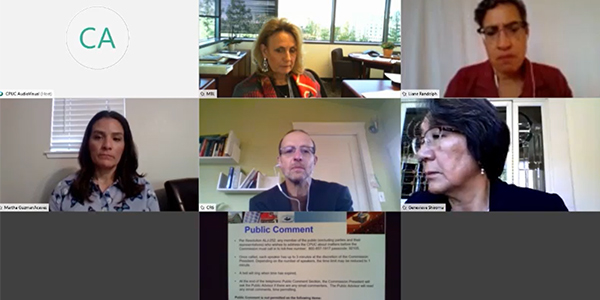By Hudson Sangree
The California Public Utilities Commission approved historic increases in the state’s clean energy targets Thursday, calling for almost 25 GW of renewable energy and storage by 2030 at an estimated cost of $45 billion (16-02-007).
The CPUC’s new reference system portfolio (RSP) targets adding 11 GW of utility-scale solar; 3.4 GW of wind; 1 GW of pumped storage; and 8.9 GW of battery storage — eight times the total installed battery capacity nationwide as of 2018, the commission said.
Load-serving entities — including the state’s three big investor-owned utilities and a growing number of community choice aggregators — must use the reference portfolio figures, which the CPUC describes as “optimal” outcomes, in their individual integrated resource plans in 2020. The RSP also is used by CAISO in its annual transmission planning process.
The goal of the effort is to help the state reach its goal of providing 100% “renewable and zero-carbon” energy to retail customers by 2045, as mandated by Senate Bill 100, passed in 2018.
CPUC President Marybel Batjer thanked fellow commissioners, staff and stakeholders before the unanimous vote.
“I think [this] is a very, very good decision, one that will double the clean energy capacity of the state over the next 10 years and one I do believe will keep us on track for the 2045 goals that we must meet … not only for the good of California, but really for the good of the world.”
GHG Reduction not Enough?
Not everyone was as thrilled as Batjer with the result.
The Natural Resources Defense Council issued a statement Thursday saying the CPUC’s order didn’t do enough to address climate change because it maintained a target of reaching a greenhouse gas emissions level of 46 million metric tons by 2030 — the same figure the CPUC adopted in its last two-year IRP cycle.
“Despite recommendations to the contrary from the entire environmental community, multiple electricity providers and even the CPUC’s own Public Advocates Office, the commission adopted a proposal with a relatively high emissions scenario as the state’s reference system plan to guide California’s electricity providers for the next two years,” the NRDC said.
However, the plan also requires retail electric providers to outline how they would reach a more ambitious target of 38 million metric tons, a concession to the chorus of those calling for greater GHG reductions.
Commissioner Clifford Rechtschaffen voted for the plan but expressed support for the stricter target in his comments.
Commissioner Liane Randolph, who headed the effort to draft the new reference portfolio, acknowledged not everyone was completely satisfied with the result but said there would be opportunities to revisit the GHG reduction target in the next two years.
“Having LSEs submit their plans toward the additional target of 38 MMT [million metric tons] will allow us to conduct a more practical and less theoretical analysis of what resources are needed to achieve that … target from the perspective of the individual LSEs doing the planning and procurement,” Randolph said.
The 46 MMT figure is 56% below 1990 levels and would exceed the state’s legislative mandate to reduce GHG by 40% below 1990 levels over the next decade, the CPUC said.
Renewables, Storage to Double
Randolph said the dramatic increase in renewable energy and storage statewide deserves praise.
“The decision adopted today provides guidance to load-serving entities to go out and procure approximately double the amount of renewable and storage capacity that is currently online in the electric system in California,” she said in a statement.
From 2020 to 2030, the reference portfolio projects a total increase in utility-scale solar from 16,310 MW to 25,905 MW and wind power from 7,367 MW to 10,293 MW, including 606 MW of wind power from new out-of-state transmission.
Natural gas generation would decrease by about 2.5 GW over the same period but remain as one of the state’s two main power sources, along with large-scale solar.
Commissioner Martha Guzman Aceves called for more effort to eliminate natural gas from the state’s resource mix. Methane, which accounts for about 12% of GHG emissions, has a more potent effect than carbon on global warming, she noted.
Wednesday’s vote was the culmination of a process that began with an administrative law judge seeking input in November 2018 and dozens of utilities, environmental groups, consumer advocates and others commenting on the plan’s iterations during the past 16 months.
The commissioners made their decision in a web conference because of the COVID-19 coronavirus pandemic. Technical problems with the phone company’s virtual setup plagued the commissioners, who also regulate the state’s telecommunications industry.
While obviously irritated, they didn’t threaten repercussions.




